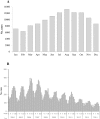Human Rabies in China, 1960-2014: A Descriptive Epidemiological Study
- PMID: 27500957
- PMCID: PMC4976867
- DOI: 10.1371/journal.pntd.0004874
Human Rabies in China, 1960-2014: A Descriptive Epidemiological Study
Abstract
Background: Rabies in China remains a public health problem. In 2014, nearly one thousand rabies-related deaths were reported while rabies geographic distribution has expanded for the recent years. This report used surveillance data to describe the epidemiological characteristics of human rabies in China including determining high-risk areas and seasonality to support national rabies prevention and control activities.
Methods: We analyzed the incidence and distribution of human rabies cases in mainland China using notifiable surveillance data from 1960-2014, which includes a detailed analysis of the recent years from 2004 to 2014.
Results: From 1960 to 2014, 120,913 human rabies cases were reported in mainland China. The highest number was recorded in 1981(0.7/100,000; 7037 cases), and in 2007(0.3/100,000; 3300 cases). A clear seasonal pattern has been observed with a peak in August (11.0% of total cases), Human rabies cases were reported in all provinces with a yearly average of 2198 from 1960 to 2014 in China, while the east and south regions were more seriously affected compared with other regions. From2004 to 2014, although the number of cases decreased by 65.2% since 2004 from 2651 to 924 cases, reported areas has paradoxically expanded from 162 prefectures to 200 prefectures and from southern to the central and northern provinces of China. Farmers accounted most of the cases (65.0%); 50-59 age group accounted for the highest proportion (20.5%), and cases are predominantly males with a male-to-female ratio of 2.4:1 on average.
Conclusions: Despite the overall steady decline of cases since the peak in 2007, the occurrence of cases in new areas and the spread trend were obvious in China in recent years. Further investigations and efforts are warranted in the areas have high rabies incidence to control rabies by interrupting transmission from dogs to humans and in the dog population. Furthermore, elimination of rabies should be eventually the ultimate goal for China.
Conflict of interest statement
The authors have declared that no competing interests exist.
Figures





References
-
- WHO \textbar About rabies [Internet]. Available: http://www.who.int/rabies/about/en/
Publication types
MeSH terms
Grants and funding
LinkOut - more resources
Full Text Sources
Other Literature Sources
Medical

